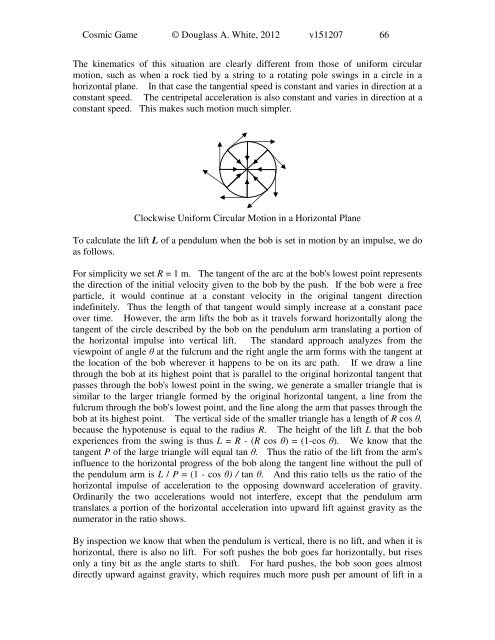Create successful ePaper yourself
Turn your PDF publications into a flip-book with our unique Google optimized e-Paper software.
<strong>Cosmic</strong> <strong>Game</strong> © Douglass A. White, 2012 v151207 66<br />
<strong>The</strong> kinematics of this situation are clearly different from those of uniform circular<br />
motion, such as when a rock tied by a string to a rotating pole swings in a circle in a<br />
horizontal plane. In that case the tangential speed is constant and varies in direction at a<br />
constant speed. <strong>The</strong> centripetal acceleration is also constant and varies in direction at a<br />
constant speed. This makes such motion much simpler.<br />
Clockwise Uniform Circular Motion in a Horizontal Plane<br />
To calculate the lift L of a pendulum when the bob is set in motion by an impulse, we do<br />
as follows.<br />
For simplicity we set R = 1 m. <strong>The</strong> tangent of the arc at the bob's lowest point represents<br />
the direction of the initial velocity given to the bob by the push. If the bob were a free<br />
particle, it would continue at a constant velocity in the original tangent direction<br />
indefinitely. Thus the length of that tangent would simply increase at a constant pace<br />
over time. However, the arm lifts the bob as it travels forward horizontally along the<br />
tangent of the circle described by the bob on the pendulum arm translating a portion of<br />
the horizontal impulse into vertical lift. <strong>The</strong> standard approach analyzes from the<br />
viewpoint of angle θ at the fulcrum and the right angle the arm forms with the tangent at<br />
the location of the bob wherever it happens to be on its arc path. If we draw a line<br />
through the bob at its highest point that is parallel to the original horizontal tangent that<br />
passes through the bob's lowest point in the swing, we generate a smaller triangle that is<br />
similar to the larger triangle formed by the original horizontal tangent, a line from the<br />
fulcrum through the bob's lowest point, and the line along the arm that passes through the<br />
bob at its highest point. <strong>The</strong> vertical side of the smaller triangle has a length of R cos θ,<br />
because the hypotenuse is equal to the radius R. <strong>The</strong> height of the lift L that the bob<br />
experiences from the swing is thus L = R - (R cos θ) = (1-cos θ). We know that the<br />
tangent P of the large triangle will equal tan θ. Thus the ratio of the lift from the arm's<br />
influence to the horizontal progress of the bob along the tangent line without the pull of<br />
the pendulum arm is L / P = (1 - cos θ) / tan θ. And this ratio tells us the ratio of the<br />
horizontal impulse of acceleration to the opposing downward acceleration of gravity.<br />
Ordinarily the two accelerations would not interfere, except that the pendulum arm<br />
translates a portion of the horizontal acceleration into upward lift against gravity as the<br />
numerator in the ratio shows.<br />
By inspection we know that when the pendulum is vertical, there is no lift, and when it is<br />
horizontal, there is also no lift. For soft pushes the bob goes far horizontally, but rises<br />
only a tiny bit as the angle starts to shift. For hard pushes, the bob soon goes almost<br />
directly upward against gravity, which requires much more push per amount of lift in a





